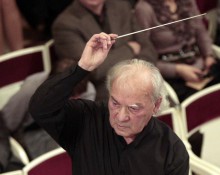The maestro will perform with the Philharmonic Symphony Orchestra on the stage of the Lysenko Columned Hall on February 16. The name given to the concert comes from a waltz of the same name, written by Carl Maria von Weber, a 19th-century German composer who dedicated the piece to his bride, Carolina Brandt (“To my Carolina,” the dedication reads). The composition was written for the piano, but another classic, French composer Hector Berlioz, later rearranged it for the orchestra. It was Berlioz’s instrumentation that made the piece enduringly popular, even to this day.
However, the premises now housing the Lysenko Columned Hall of the National Philharmonic Society really accommodated dancers in the late 19th century. It was once the House of the Merchant Assembly, built to the design of the famous Kyiv architect Vladimir Nikolayev. The building’s centerpiece was its dance hall which could accommodate 1,300 people. According to some sources, it was illuminated by three large chandeliers and supported by columns of exquisite form, made of material resembling white marble. It is there that balls were held which one can only dream about now.
Another story, indirectly related to dance, is contained in the biography of Roman Kofman himself. The renowned maestro began his conducting career in Pavlo Virsky’s dance company, where he “accidentally” took part in the competition for the post of the second conductor of the company’s orchestra. According to Kofman, it was a gamble to an extent, for he had no conductor diploma then, having graduated from Kyiv Conservatory as a violinist. But it turned out that literally immediately after his appointment, the company was invited to tour the US, and Kofman conducted 24 concerts there... And on his return to the home country, he entered the conducting department of Kyiv Conservatory.
The concert program, in addition to Weber’s Invitation to Dance, includes waltzes by Charles Gounod, Dmitri Shostakovich, Eugen Doga, Reinhold Gliere, Jean Sibelius, as well as The Slavonic Dances by Antonin Dvorak and The Hungarian Dances by Johannes Brahms.







